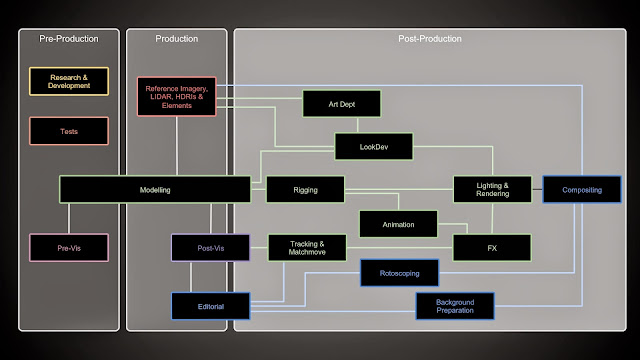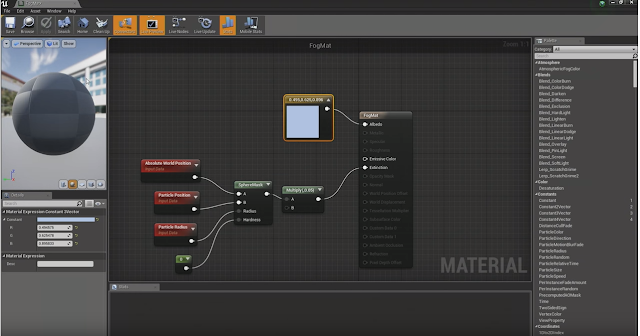Pre-Production and the workflow pipeline
I first came to Taiwan with my girlfriend over 6 years ago. She's now my wife and I've started a new chapter in life. I originally worked as an English Teacher with a school for 5 years until I could apply for a permanent visa. Without this, I couldn't apply for work within the film production industry without asking my new employer to pay for it. Without prior experience nor a solid background in the business, this wasn't likely to happen. But everything fell into place nicely, as it did six years ago whilst thinking about visiting Taiwan for the first time. Some moments in life present huge opportunities for great change, luckily I was ready.
So, what's it all about. Many people ask me about my job and what I do. I am a Production Technical Director. but honestly this often confuses them as I try to explain specifics. The purpose of this blog is to quickly define the pre-production pipeline and where I fit in.
According to Wikipedia, Pre-production is the process of fixing some of the elements involved in a film, play, or other performance. There are three parts in a production: pre-production, production, and post-production. Pre-production ends when the planning ends and the content starts being produced.
In filmmaking and video production, pre-production formally begins once a project has been greenlit. At this stage, finalizing preparations for production go into effect. Financing will generally be confirmed and many of the key elements such as principal cast members, director and cinematographer are set. By the end of pre-production, the screenplay is usually finalized and satisfactory to all the financiers and other stakeholders.
During pre-production, the script is broken down into individual scenes storyboards and all the locations, props, cast members, costumes, special effects and visual effects are identified. An extremely detailed schedule is produced and arrangements are made for the necessary elements to be available to the film-makers at the appropriate times. Sets are constructed, the crew is hired, financial arrangements are put in place and a start date for the beginning of principal photography is set. At some point in pre-production there will be a read-through of the script which is usually attended by all cast members with speaking parts, the director, all heads of departments, financiers, producers, and publicists.
Even though the writer may still be working on it, the screenplay is generally page-locked and scene-numbered at the beginning of pre-production to avoid confusion. This means that even though additions and deletions may still be made, any particular scene will always fall on the same page and have the same scene number.

Once the project is greenlit, we start going to work. This diagram is excellent for departments and the connectivity they have. I work in the Pre-vis team but also build models for Research and Development. Often these models need to be rigged and animated with some basic look development. As you can quickly see, this covers all three sections and can quickly become difficult to manage without proper pipeline mechanics. As the projects grow in number and scale, so will the departments and teams. Next time you watch a movie, have a look at all the companies and artists involved in the visual effects. It's mind blowing.
According to Wikipedia, Pre-production is the process of fixing some of the elements involved in a film, play, or other performance. There are three parts in a production: pre-production, production, and post-production. Pre-production ends when the planning ends and the content starts being produced.
In filmmaking and video production, pre-production formally begins once a project has been greenlit. At this stage, finalizing preparations for production go into effect. Financing will generally be confirmed and many of the key elements such as principal cast members, director and cinematographer are set. By the end of pre-production, the screenplay is usually finalized and satisfactory to all the financiers and other stakeholders.
During pre-production, the script is broken down into individual scenes storyboards and all the locations, props, cast members, costumes, special effects and visual effects are identified. An extremely detailed schedule is produced and arrangements are made for the necessary elements to be available to the film-makers at the appropriate times. Sets are constructed, the crew is hired, financial arrangements are put in place and a start date for the beginning of principal photography is set. At some point in pre-production there will be a read-through of the script which is usually attended by all cast members with speaking parts, the director, all heads of departments, financiers, producers, and publicists.
Even though the writer may still be working on it, the screenplay is generally page-locked and scene-numbered at the beginning of pre-production to avoid confusion. This means that even though additions and deletions may still be made, any particular scene will always fall on the same page and have the same scene number.

Once the project is greenlit, we start going to work. This diagram is excellent for departments and the connectivity they have. I work in the Pre-vis team but also build models for Research and Development. Often these models need to be rigged and animated with some basic look development. As you can quickly see, this covers all three sections and can quickly become difficult to manage without proper pipeline mechanics. As the projects grow in number and scale, so will the departments and teams. Next time you watch a movie, have a look at all the companies and artists involved in the visual effects. It's mind blowing.


